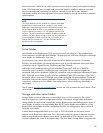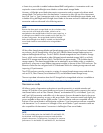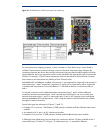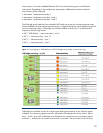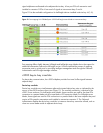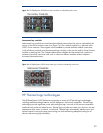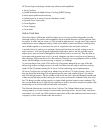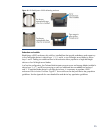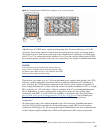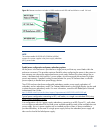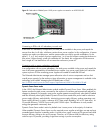HP Thermal Logic technologies include many elements and capabilities:
• Active Cool fans
• Parallel Redundant Scalable Enclosure Cooling (PARSEC) design
• Instant power and thermal monitoring
• Pooled power for a variety of power redundancy modes
• Dynamic Power Saver mode
• Power Regulator
• Power Capping
• Power Meter
Active Cool fans
Quite often, dense, full-featured, small form-factor servers use very small fans designed to provide
localized cooling in the specific areas needed by the server blade. Because such fans generate fairly
low airflow (in cubic feet per minute, or CFM) at medium backpressure, a single server often requires
multiple fans to ensure adequate cooling. If each server blade contains several fans, installing many
server blades together in an enclosure can result in a significant cost and space overhead.
A second solution for cooling is to use larger, blower-style fans that can provide cooling across an
entire enclosure. Such fans are good at generating high-volume airflow, but they typically require
higher power input and must be designed for the maximum load in an enclosure. They also take up
more space and generate more noise. As a result, designers may have to sacrifice server features to
allow the large, high-power fans to fit in the enclosure. Even then, ensuring adequate airflow to all the
servers without leakage, over provisioning, or bypass is a challenge.
To overcome these issues in the c3000 enclosure, HP engineers designed a new type of fan that
delivers high airflow and high pressure in a small form factor that can scale to meet future cooling
needs. HP has 20 patents pending for its Active Cool fan technology and its implementation.
HP Active Cool fans can cool eight server blades using as little as 100 watts of power. Active Cool
fans use ducted fan technology with a high-performance motor and impeller (Figure 15) to deliver
high CFM at high pressure. The fan includes a bell mouth inlet with a specially designed impeller and
a stator section that also provides cooling fins for the motor and acoustic treatments at the rear of the
fan. This design provides cooling capacity to support blade products beyond current roadmaps. The
fan’s unique shape allows for high-volume, high-pressure airflow at even the slowest fan speeds, while
maintaining low noise levels and minimal power consumption.
The Onboard Administrator controls the Active Cool fans. The Onboard Administrator can ramp
cooling capacity up or down based on system needs, optimizing airflow, acoustic levels, and power
consumption. As a result, the c3000 enclosure requires less airflow than traditional rack-mount servers
to properly cool the server blades within the enclosure.
23




